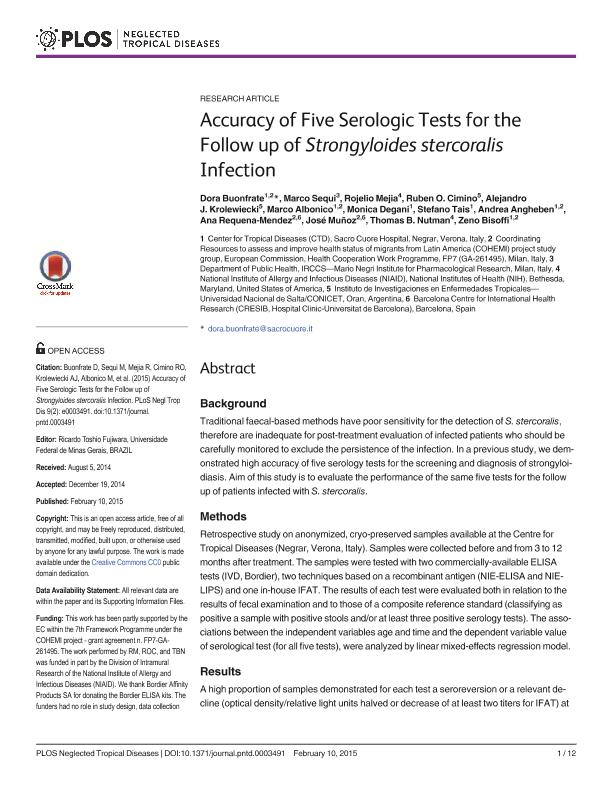Artículo
Accuracy of Five Serologic Tests for the Follow up of Strongyloides stercoralis Infection
Buonfrate, Dora; Sequi, Marco; Mejia, Rojelio; Cimino, Ruben Oscar; Krolewiecki, Alejandro Javier ; Albonico, Marco; Degani, Monica; Tais, Stefano; Angheben, Andrea; Requena Mendez, Ana; Muñoz, Jose; Nutman, Thomas; Bisoffi, Zeno
; Albonico, Marco; Degani, Monica; Tais, Stefano; Angheben, Andrea; Requena Mendez, Ana; Muñoz, Jose; Nutman, Thomas; Bisoffi, Zeno
 ; Albonico, Marco; Degani, Monica; Tais, Stefano; Angheben, Andrea; Requena Mendez, Ana; Muñoz, Jose; Nutman, Thomas; Bisoffi, Zeno
; Albonico, Marco; Degani, Monica; Tais, Stefano; Angheben, Andrea; Requena Mendez, Ana; Muñoz, Jose; Nutman, Thomas; Bisoffi, Zeno
Fecha de publicación:
10/02/2015
Editorial:
Public Library Of Science
Revista:
Neglected Tropical Diseases
ISSN:
1935-2735
Idioma:
Inglés
Tipo de recurso:
Artículo publicado
Clasificación temática:
Resumen
Background
Traditional faecal-based methods have poor sensitivity for the detection of S. stercoralis, therefore are inadequate for post-treatment evaluation of infected patients who should be carefully monitored to exclude the persistence of the infection. In a previous study, we demonstrated high accuracy of five serology tests for the screening and diagnosis of strongyloidiasis. Aim of this study is to evaluate the performance of the same five tests for the follow up of patients infected with S. stercoralis.
Methods
Retrospective study on anonymized, cryo-preserved samples available at the Centre for Tropical Diseases (Negrar, Verona, Italy). Samples were collected before and from 3 to 12 months after treatment. The samples were tested with two commercially-available ELISA tests (IVD, Bordier), two techniques based on a recombinant antigen (NIE-ELISA and NIE-LIPS) and one in-house IFAT. The results of each test were evaluated both in relation to the results of fecal examination and to those of a composite reference standard (classifying as positive a sample with positive stools and/or at least three positive serology tests). The associations between the independent variables age and time and the dependent variable value of serological test (for all five tests), were analyzed by linear mixed-effects regression model.
Results
A high proportion of samples demonstrated for each test a seroreversion or a relevant decline (optical density/relative light units halved or decrease of at least two titers for IFAT) at follow up, results confirmed by the linear mixed effects model that showed a trend to seroreversion over time for all tests. In particular, IVD-ELISA (almost 90% samples demonstrated relevant decline) and IFAT (almost 87%) had the best performance. Considering only samples with a complete negativization, NIE-ELISA showed the best performance (72.5% seroreversion).
Conclusions
Serology is useful for the follow up of patients infected with S. stercoralis and determining test of cure
Palabras clave:
Strongyloides Stercoralis
,
Serología
,
Elisa
,
Geohelmintos
Archivos asociados
Licencia
Identificadores
Colecciones
Articulos(CCT - SALTA-JUJUY)
Articulos de CTRO.CIENTIFICO TECNOL.CONICET - SALTA-JUJUY
Articulos de CTRO.CIENTIFICO TECNOL.CONICET - SALTA-JUJUY
Articulos(IPE)
Articulos de INST.DE PATOLOGIA EXPERIMENTAL
Articulos de INST.DE PATOLOGIA EXPERIMENTAL
Citación
Buonfrate, Dora; Sequi, Marco; Mejia, Rojelio; Cimino, Ruben Oscar; Krolewiecki, Alejandro Javier; et al.; Accuracy of Five Serologic Tests for the Follow up of Strongyloides stercoralis Infection; Public Library Of Science; Neglected Tropical Diseases; 9; 2; 10-2-2015; e0003491-e0003491
Compartir
Altmétricas



